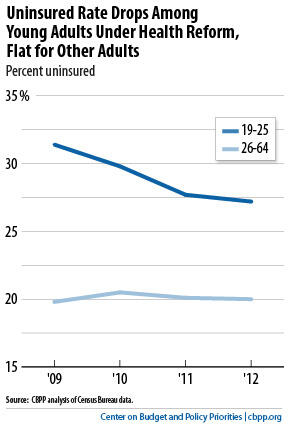off the charts
POLICY INSIGHT
BEYOND THE NUMBERS
BEYOND THE NUMBERS
Today’s Census Bureau health insurance coverage data do not reveal much about the impact of health reform. That’s because the Census data reflect the number of people with and without health insurance coverage in 2012, but health reform’s major coverage expansion provisions will not take effect until 2014. But, anyone examining the Census data should keep the following in mind:
- Health reform has increased coverage among young adults. While the share of 19- to 25-year-olds without health insurance coverage remained unchanged between 2011 and 2012, it has fallen by 4.2 percentage points since 2009 (see chart). Under health reform, adult children have been able to enroll in their parents’ health insurance plan up to their 26th birthday since September 2010. This provision was likely the biggest reason for the drop in uninsured young adults.
Image

- Health reform required states to maintain their Medicaid and Children’s Health Insurance Program (CHIP) eligibility and enrollment procedures (through 2019 for children and until 2014 for adults). That allowed the overall share of people with Medicaid and CHIP to hold steady between 2011 and 2012. Along with gains in private coverage in 2012, stable Medicaid and CHIP coverage helped cut the rate of children without health insurance coverage in 2012 to 8.9 percent, a historically low mark. Medicaid and CHIP enrollment for adults has also increased, but not by enough to compensate for reductions in private coverage between 1999 and 2012; the uninsured rate rose more than 25 percent among non-elderly adults over that period.
- Health reform can address regional inequities in health insurance coverage. The South remains the region with the greatest share of uninsured people, at 18.6 percent. Most of the states in this region, however, don’t plan to take up health reform’s Medicaid expansion to low-income adults, even though the federal government will pick up the vast majority of the cost. More Southern states opting for the expansion would produce large coverage gains.
- Health reform can fill the coverage gaps that exist today for those without access to employer-based coverage or who are unemployed. Employer-based coverage remains the primary source of coverage in the United States. Indeed, 54.9 percent of Americans had employer-based coverage in 2012. But, the uninsured rates among those working only part-time (27.7 percent) and those without a job (25.8 percent) are much higher than the overall uninsured rate. Health reform’s new health insurance exchanges (also known as marketplaces) and premium subsidies to purchase exchange plans will offer these individuals quality, affordable health insurance coverage irrespective of their employment circumstances.
We’ll take a closer look at the Census findings in a report tomorrow.
Blog
Continued Progress Insuring Americans — Notably Children — in 2012, Census Data Show
September 17, 2013
Stay up to date
Receive the latest news and reports from the Center
